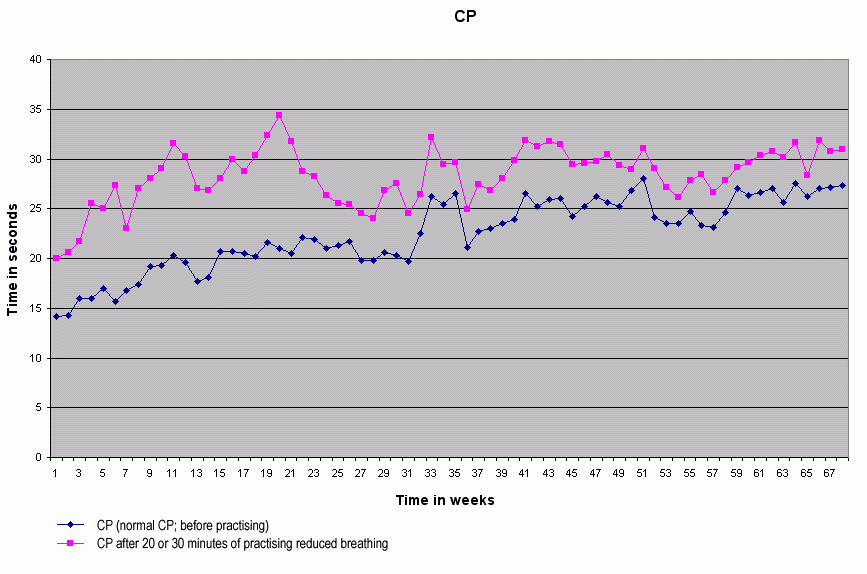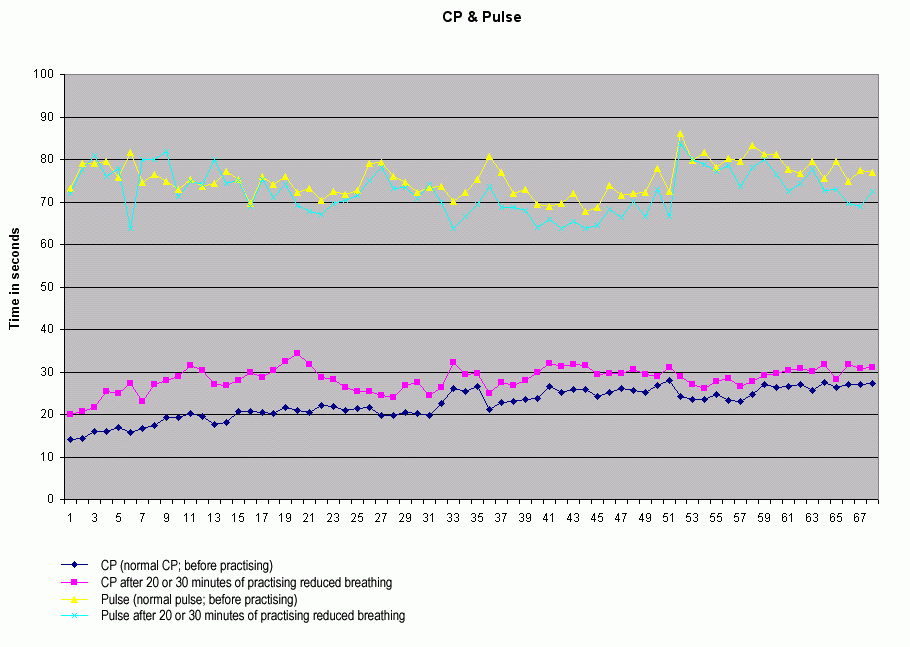Real-life example of fighting chronic hyperventilation
Below you see two diagrams showing the progress I have made challenging my chronic hyperventilation with Buteyko reduced breathing exercises. Shown is how my CP (Control Pause; the navy blue line) and my pulse (the yellow line) developed during the period I did the exercises. The higher the CP, the less I am overbreathing and the healthier I am. As you can see, my CP is generally higher and my pulse lower after I do the breathing exercises. In other words: for a specific week, the blue line is lower than the magenta line.
At the moment I am definitely feeling better than when I started doing my exercises, but I'm not healthy yet. As you can see, changing my breathing patterns is a quite an undertaking, since I have been doing my reduced breathing exercises for over a year now, which take me almost an hour and a half a day. And since the average CP is somewhere around 35 seconds, and the CP you should strive for is 60 seconds, I still have some years to go.
The statistics and diagrams have been generated with the Buteyko StopWatch, a free program for measuring, saving and calculating (the progress) of your Control Pause. For every week the average CP is calculated: every dot represents a week.

Some interesting events that influenced my breathing:
Weeks 12-15: a clearing reaction happens around a CP of 20 seconds, exactly as predicted by the Buteyko literature. Slowly, my memory problems diminish around this time, I am less fatigued and I also feel somewhat more clear in my head. The next three months are really depressing, since my CP does not seem to get any higher.
Week 21: I stop doing my reduced breathing exercises with a 'locked' throat. I am now doing them while relaxing as much as possible. I wasn't able to do this before, since my stomach would get all stressed up and I would feel really uncomfortable. Forcing it with a locked throat did the trick, although it wasn't the correct way to exercise. As the graphic shows, my normal CP isn't directly influenced by this switch in techniques, but my after-exercising-CP slowly drops in the months that follow. The cause of this is that with a locked throat I could practice somewhat more 'extreme'.
Week 27: my girlfriend breaks up our relationship. For the first time in months my CP drops down below 20. Suddenly I feel more clouded in my head again. In addition, I cannot do my reduced breathing exercises relaxed anymore, so I do them with my throat locked for the weeks to come.
Weeks 32-35: on doctors orders I am experimenting with an antidepressant (Paroxetine), which has quite some effect on my CP and the ease with which I can do my breathing exercises. After three weeks, I stop taking the Paroxetine and am starting to do less breathing exercises a day (two sets per day instead of three). Maybe this more relaxed attitude was the cause of my CP rising in the weeks that followed.
Week 41: I am starting to take magnesium. The first week has a noticeable positive effect on my breathing and also gives me severe headaches.
Week 45: eating peanuts every night, I am testing whether the peanut allergy - which the blood test says I have - has an effect on my breathing. It seems it does.
Weeks 50-51: I'm taking the last Paroxetine pills I had saved. Only half a pil a day, but the effects are still noticeable.
Weeks 52-58: I am experiencing an old anxiety again. Back with a vengeance, it's pulling my CP below 25 and pushing my pulse above 80.
Below you can also see my pulse. What's quite interesting is that my pulses' behavior before and after exercising are erratic at first. However, in the months that follow, my pulse after doing the exercises is consistently lower than before doing them. You can also see that in times of psychological stress, my pulse gets high again and the relationship between the 'before' and 'after' pulse somewhat less stable.

Some other statistics:
I probably did some 600 hours of formal Buteyko reduced breathing exercises.
In 59 weeks I did almost 3500 CP-measurements.
I do mostly 3 sets of exercises in one session. I started with 3 times 5 minutes. I now do 3 times 10 minutes. I do 2 sessions a day (I used to do 3 sessions every day).
Sorry for all the statistics and numbers, but I can't help myself: I work at a Dutch statistics office...
Go to homepage.


